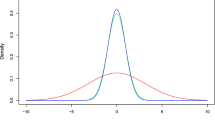Abstract
This paper shows how to build in a computationally efficient way a maximum simulated likelihood procedure to estimate the Cox–Ingersoll–Ross model from multivariate time series. The advantage of this estimator is that it takes into account the exact likelihood function while avoiding the huge computational burden associated with MCMC methods and without the ad hoc assumption that certain bond yields are measured without error. The proposed methodology is implemented and tested on simulated data. For realistic parameter values the estimator seems to have good small sample properties, compared to the popular quasi maximum likelihood approach, even using moderate simulation sizes. The effect of simulation errors does not seem to undermine the estimation procedure.
Similar content being viewed by others
References
Bakshi S. B., Chen Z. (1997) An alternative valuation model for contingent claims. Journal of Financial Economics 44: 123–165
Ball C. A., Tourous W. N. (1996) Unit roots and the estimation of interest rate dynamics. Journal of Empirical Finance 3: 215–238
Brigo, D., & Mercurio, F. (2000). The CIR++ model and other deterministic-shift extensions of short rate models. In Proceedings of the 4th Columbia-JAFEE conference for mathematical finance and financial engineering (pp. 563–584), Tokyo, 16–17 December.
Chiarella C., Hung H., Tô T.-D. (2009) The volatility structure of the fixed income market under the HJM framework: A nonlinear filtering approach. Computational Statistics and Data Analysis 53: 2075–2088
Chiarella C., Tô T.-D. (2006) The multifactor nature of the volatility of futures markets. Computational Economics 27: 163–183
Cox J. C., Ingersoll J. E., Ross S. (1985) A theory of the term structure of interest rates. Econometrica 53: 385–407
Dai Q., Singleton K. J. (2000) Specification analysis of affine term structure models. Journal of Finance 55: 1943–1978
de Jong F. (2000) Time-series and cross-section information in affine term structure models. Journal of Business and Economic Statistics 18: 300–314
de Jong F., Santa-Clara P. (1999) The dynamics of the forward interest rate curve: A formulation with state variables. Journal of Financial and Quantitative Analysis 34: 131–157
Doucet A., de Freitas N., Gordon N. (2001) An introduction to sequential Monte Carlo methods. In: Doucet A., de Freitas N., Gordon N. (eds) Sequential Monte Carlo methods in practice. Springer, New York, pp 3–14
Doucet A., Godsill S., Andrieu C. (2000) On sequential Monte Carlo sampling methods for Bayesian filtering. Statistics and Computing 10: 197–208
Doucet A., Tadić V. B. (2003) Parameter estimation in general state-space models using particle methods. Annals of the Institute of Mathematical Statistics 55: 409–422
Duan J. C., Simonato J. G. (1999) Estimating and testing exponential-affine term structure models by Kalman filter. Review of Quantitative Finance and Accounting 13: 102–127
Duffee G. R. (1999) Estimating the price of default risk. Review of Financial Studies 12: 197–226
Duffee, G. R., & Stanton, R. (2004). Estimation of dynamic term structure models. Working Paper, University of Berkeley.
Durham G. B., Gallant A. R. (2002) Numerical techniques for maximum likelihood estimation of continuous-time diffusion processes. Journal of Business and Economic Statistics 20: 325–327
Geyer A. L. J., Pichler S. (1999) A state-space approach to estimate and test multifactor Cox–Ingersoll–Ross models of the term structure. Journal of Financial Research 23: 107–130
Godsill S. J., Doucet A., West M. (2004) Monte Carlo smoothing for nonlinear time series. Journal of the American Statistical Association 99: 156–168
Harvey A. C., De Rossi G. (2006) Signal extraction. In: Mills T. C., Patterson K. (eds) Palgrave handbook of econometrics: Volume 1 econometric theory. Palgrave Macmillan, Basingstoke
Hull J., White A. (1990) Pricing interest rate derivative securities. Review of Financial Studies 3: 573–592
Hürzeler M., Künsch H. R. (2001) Approximating and maximising the likelihood for a general state-space model. In: Doucet A., de Freitas N., Gordon N. (eds) Sequential Monte Carlo methods in practice. Springer, New York, pp 159–176
Kitagawa G. (1996) Monte Carlo filter and smoother for non-Gaussian nonlinear state space models. Journal of Computational and Graphical Statistics 5: 1–25
Lamoureux C., Witte H. D. (2002) Empirical analysis of the yield curve: The information in the data viewed through the window of Cox, Ingersoll and Ross. Journal of Finance 57: 1479–1520
Longstaff F. A., Schwartz S. (1992) Interest rate volatility and the term structure: A two factor general equilibrium model. Journal of Finance 47: 1259–1282
Lund, J. (1997). Econometric analysis of continuous-time arbitrage-free models of the term structure of interest rates. Unpublished Working Paper, Aarhus School of Business.
Michalewicz Z. (1999) Genetic Algorithms + Data Structures = Evolution Programs. Springer-Verlag, Berlin
Pitt, M. (2002). Smooth particle filters for likelihood evaluation and maximisation. Warwick Economic Research Papers, Department of Economics, 651.
Pitt M., Shephard N. (1999) Filtering via simulation: Auxiliary particle filters. Journal of the American Statistical Association 94: 590–599
Takahashi A., Sato S. (2001) Monte Carlo filtering approach for estimating the term structure of interest rates. Annals of the Institute of Statistical Mathematics 53: 50–62
Author information
Authors and Affiliations
Corresponding author
Rights and permissions
About this article
Cite this article
De Rossi, G. Maximum Likelihood Estimation of the Cox–Ingersoll–Ross Model Using Particle Filters. Comput Econ 36, 1–16 (2010). https://doi.org/10.1007/s10614-010-9208-0
Accepted:
Published:
Issue Date:
DOI: https://doi.org/10.1007/s10614-010-9208-0




